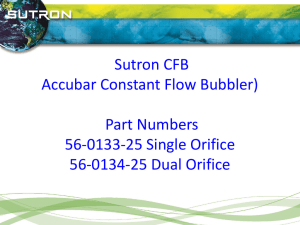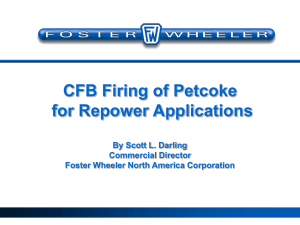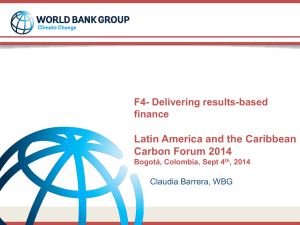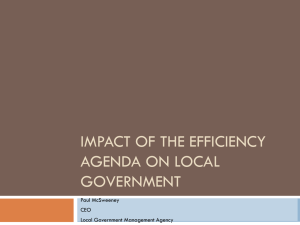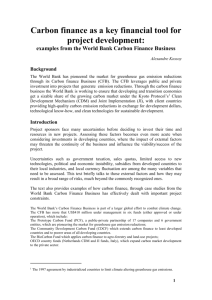THE CARBON FINANCE PROJECT CYCLE
advertisement
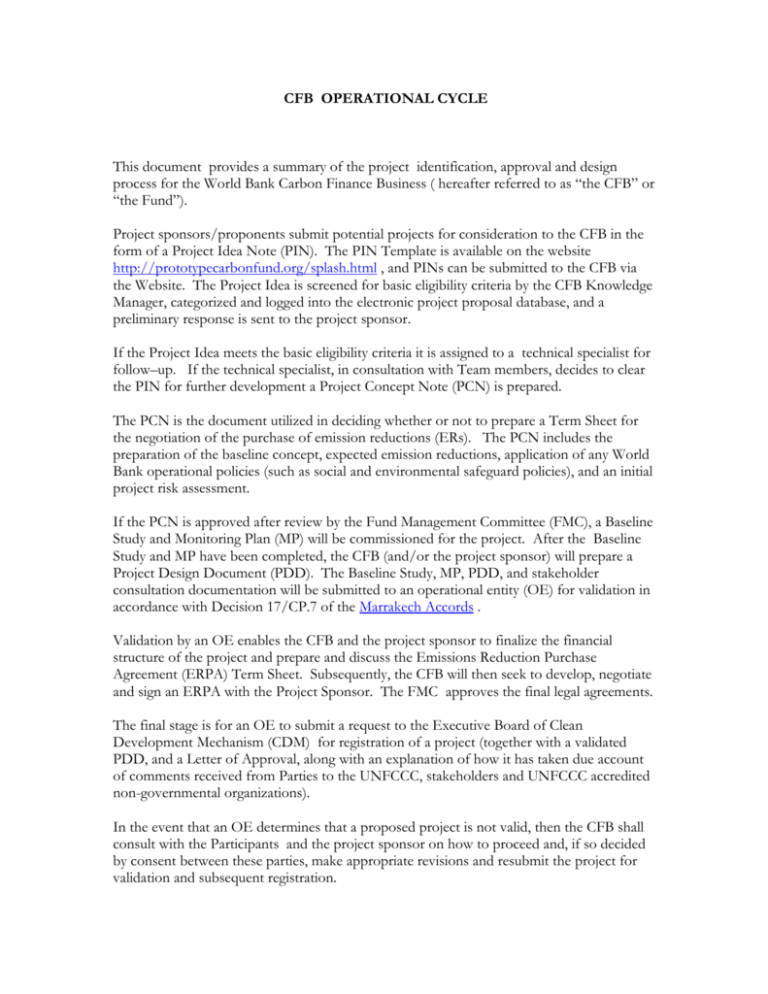
CFB OPERATIONAL CYCLE This document provides a summary of the project identification, approval and design process for the World Bank Carbon Finance Business ( hereafter referred to as “the CFB” or “the Fund”). Project sponsors/proponents submit potential projects for consideration to the CFB in the form of a Project Idea Note (PIN). The PIN Template is available on the website http://prototypecarbonfund.org/splash.html , and PINs can be submitted to the CFB via the Website. The Project Idea is screened for basic eligibility criteria by the CFB Knowledge Manager, categorized and logged into the electronic project proposal database, and a preliminary response is sent to the project sponsor. If the Project Idea meets the basic eligibility criteria it is assigned to a technical specialist for follow–up. If the technical specialist, in consultation with Team members, decides to clear the PIN for further development a Project Concept Note (PCN) is prepared. The PCN is the document utilized in deciding whether or not to prepare a Term Sheet for the negotiation of the purchase of emission reductions (ERs). The PCN includes the preparation of the baseline concept, expected emission reductions, application of any World Bank operational policies (such as social and environmental safeguard policies), and an initial project risk assessment. If the PCN is approved after review by the Fund Management Committee (FMC), a Baseline Study and Monitoring Plan (MP) will be commissioned for the project. After the Baseline Study and MP have been completed, the CFB (and/or the project sponsor) will prepare a Project Design Document (PDD). The Baseline Study, MP, PDD, and stakeholder consultation documentation will be submitted to an operational entity (OE) for validation in accordance with Decision 17/CP.7 of the Marrakech Accords . Validation by an OE enables the CFB and the project sponsor to finalize the financial structure of the project and prepare and discuss the Emissions Reduction Purchase Agreement (ERPA) Term Sheet. Subsequently, the CFB will then seek to develop, negotiate and sign an ERPA with the Project Sponsor. The FMC approves the final legal agreements. The final stage is for an OE to submit a request to the Executive Board of Clean Development Mechanism (CDM) for registration of a project (together with a validated PDD, and a Letter of Approval, along with an explanation of how it has taken due account of comments received from Parties to the UNFCCC, stakeholders and UNFCCC accredited non-governmental organizations). In the event that an OE determines that a proposed project is not valid, then the CFB shall consult with the Participants and the project sponsor on how to proceed and, if so decided by consent between these parties, make appropriate revisions and resubmit the project for validation and subsequent registration. The details of the approval and project design process follow. 1. Step by Step Process Review 1.1 Project Identification through the Project Idea Note Project Sponsors/proponents submit potential projects to the CFB for consideration in the form of a Project Idea Note (PIN). The PIN Template is available on the CFB website http://prototypecarbonfund.org/splash.html and PINs can be submitted to the CFB via the Website. Project sponsors may be public- or private-sector entities. If the Project Idea meets the basic eligibility criteria it is assigned to a technical specialist for follow-up. The following information is required in a PIN: Description of Project Sponsor Type of Project (e.g., renewable energy, energy efficiency, waste management) Location of Project Expected Schedule Financing Sought Technical Summary of Project Expected Environmental Benefits (local and global) While there is no formal project review at this stage, a formal email will be sent to Participants detailing the decision to proceed to PCN stage with the project, outlining salient technical details. At this stage, the Project Sponsor may be requested to provide a Letter of Intent ( LoI), embodying exclusivity. A Letter of Intent is signed by the potential seller of emission reductions and the World Bank as trustee of the CFB. With this document the CFB declares its intention to purchase emission reductions generated by a specific project under terms to be agreed in return for the exclusive right to contract for the purchase of emission reductions. By signing this letter the project entity commits itself to repay project preparation costs if it decides not to proceed to negotiate an Emission Reductions Purchase Agreement with the CFB as Trustee in relation to the project. 1.2 Letter of Endorsement/No Objection and the Project Concept Note (PCN) The next step is to request a Letter of Endorsement or a Letter of No Objection from the Host Country Government to ensure that there is support for the project. This letter is a unilateral document issued by a CFB host country very early in the process of project identification. With this letter the CFB obtains the general consent from the host country for the further development of the project as a CDM project. The CFB seeks to obtain such a letter when it receives a Project Idea Note on a project which is considered viable before it goes into further development. Upon receipt of a Letter of Endorsement/ Letter of No Objection from the host country, the CFB works with the project sponsor to prepare a Project Concept Note (PCN) according to the agreed guidelines. The PCN includes information on the Baseline concept and information on the estimated Emission Reductions (ERs) to be purchased, along with the proposed price level and anticipated volume of carbon finance to be provided and any requirements for up-front or advance payments. It is highly preferable that a budget estimate for costs incurred in achieving a negotiated ERPA be submitted with the PCN. Preparation of a Project Concept Note is quite detailed and usually contains the following aspects: Field visits for project identification and preparation Due diligence on: o environmental and social issues, o quality of the carbon asset, o status of project financing, o the use of a technology already applied in another country; o quality and experience of project sponsors and any financial intermediaries; and Consultations with the Government on the proposed carbon-financed project. A feasibility study and a preliminary five-page Baseline Study should be attached to the PCN. After the FMC has approved the CFD, the CFB (and/or the project sponsor) can proceed to prepare the Baseline Study, MP, Project Design Document (PDD) and stakeholder consultation documentation for validation by an OE as required in Decision 17/CP.7 of the Marrakech Accords . 1.3 Preparation of the Baseline Study, Monitoring Plan, and related documents Baseline Study and Monitoring Plan (MP) The CFB commissions a Baseline Study and an MP for projects for which the PCN has been approved. Documentation to be prepared in this process includes: a Baseline Study which justifies the selected Baseline method and establishes a credible Baseline for the project and provides the basis for establishing ERs to be achieved throughout the project, a Monitoring Plan (MP) which provides the data requirements and monitoring methodology to facilitate periodic verification and certification of ERs, and a report including spreadsheets which estimate the flow and volume of ERs to be achieved throughout the project and which form the basis for negotiations of the ERPA terms. The CFB may choose to procure the services of a consultant to prepare the Baseline Study and MP, to supervise the project sponsor or an intermediary in project preparation, or to undertake some or all of this work internally. In the case of the Project Sponsor undertaking the Baseline Study, there will be no payment from the CFB for this, unless additional work is required by the Validator. In any circumstance, the Project Sponsor should participate in the selection of the Baseline consultant and Validator. While typically the CFB will commission the Baseline Study and MP together, these may be unbundled with parts undertaken by separate consultants, the project sponsor or the CFB. Environmental Review and Stakeholder Consultations All projects must comply with World Bank Group Operational Policies and Procedures, including those on environmental assessment. An Integrated Safeguard Policies review and Environmental Assessment (EA) is performed as a standard part of the appraisal of World Bank Group projects.1 If the EA determines that the project is rated in Categories A or B, an Environmental Impact Assessment ( EIA) is required. This EIA must be posted publicly for sixty days before the Emissions Reduction Purchase Agreement ( ERPA) can be signed. For all projects, documentation must be provided indicating results of any environmental and social reviews at the national and local governmental level following the guidance provided by the UNFCCC. Similarly, stakeholder consultations will be held, and the appropriate documentation provided concerning these consultations as per Decision 17/CP.7 and as a requirement for project validation. Project Design Document (PDD) The CFB prepares the Project Design Document (PDD), in conformity with Decision 17/CP.7. It is anticipated that a simplified PDD for small scale projects is to be drafted by the Small Scale Panel of the Executive Board of the CDM. PDD content is derived from: the Baseline Study and MP; environmental and social assessments ; 1 Consistent with Bank operational policies and procedures, as well as with the Articles of the Prototype Carbon Fund (PCF), CFB projects shall comply with all Bank Group Operational Policies and Procedures, (except where such policies and procedures may be inconsistent with the guidelines, modalities and procedures adopted by the Parties to the Climate Change Convention (UNFCCC) regarding the procurement of services by independent Third Parties, in which case the latter shall govern.) Based upon the foregoing, Task Team Leaders (TTLs) should process projects in a manner fully consistent with the application of all Bank policies, including, of course, safeguard and disclosure policies and procedures. Please note, however, that because CFB projects do not go to the Bank Board for approval, no less than sixty (60) days before signature by the Country Director, the CFB project documentation prepared in accordance with the safeguard policies will be made publicly available in a manner fully consistent with the safeguard policies both at the Bank information shop, and in a publicly accessible location in the CFB project country. stakeholder consultations required by the CFB and by Decision 17/CP.7; carbon asset risk assessment, (see detailed description below); draft ERPA Term Sheet; and due diligence completed on the underlying project in accordance with World Bank Group Operational Policies and Procedures. The PDD should not be more than 8 – 10 pages in length, and can be input into the World Bank Project Appraisal Document (PAD) for Bank-financed projects. The PDD, Baseline Study, MP, and stakeholder consultations documentation are made available to the public on the CFB website at the validation stage to enable stakeholders to review and comment on the project. In accordance with Decision 17/CP.7, that entity should take any such comments received into account when giving its final validation opinion. Carbon Asset Risk Assessment Experience has shown that risks associated uniquely with the creation of ERs are often not covered in due diligence of underlying projects. These may be risks associated with policy issues still to be resolved in the framework of the Clean Development Mechanism (CDM), including eligibility and Baseline risk, or they may concern technical issues of greenhouse gas emissions volumes and flow rates. Where such issues arise, the CFB undertakes additional risk assessments to complement regular project due diligence. Documents in the CFB Project Cycle The documents required in the CFB’s project cycle are shown in the attached flow chart. They include ( in cases where required) the Project Concept Document (PCD) prepared in parallel with the PCN, the safeguards policy review leading to the environment assessment and stakeholder consultation documents, and finally the Project Appraisal Document (issued after an ERPA Term Sheet or draft ERPA has been prepared and a Letter of Approval is available). After formal project appraisal, ERPA negotiations can be completed. World Bank operational policies and procedures are not applicable to CFB emission reduction purchase transactions, to the extent that for CFB projects (i) it is not required to include sections on procurement, financial management, and disbursement in the PAD; (ii) the logframe is not required; and (iii) CFB documentation (the Project Design Document) is annexed to the PCD/PAD. 1.4 Parallel Due Diligence of Underlying Project Comprehensive Due Diligence All underlying projects receiving carbon finance are appraised to confirm their financial, technical, commercial and legal feasibility and soundness. Projects with underlying World Bank Group financing are appraised as per standard procedures for World Bank Groupfinanced operations. Projects not receiving underlying World Bank Group financing will be subject to an independent appraisal and due diligence in accordance with World Bank Group standards. This work is contracted by the CFB from the relevant regional, country and sector business units of the World Bank Group so as to ensure the underlying investment will perform as expected and Emission Reductions can be generated, and that long term supervision of the underlying project takes place under ongoing quality and performance review of the IBRD’s country managers. 1.5 Validation as a CDM-eligible project In consultation with the project sponsor, the CFB select and contract an operational entity (OE) to conduct validation of the project as a CDM-eligible project2. The CFB submits to the OE the Baseline Study, MP, PDD and stakeholder consultation documents, and confirms that the environmental assessment has been undertaken in conformity with national and local government requirements, and that the Project meets the sustainable development criteria of the host country government3. The CFB and project sponsor then work with the entity performing Validation to achieve a satisfactory Validation opinion. 1.6 Pre-Negotiations To help ensure that all parties interested in the ER purchase transaction (as well as relevant outside stakeholders) fully understand the transaction and consider that it represents an equitable distribution of the benefits and risks, and hence is sustainable and fair, the CFB, host country representatives and project sponsor may organize pre-negotiation, or upstream consultations, to discuss the terms of the transaction. The CFB may also offer to assist the host country and/or project sponsor to engage independent experts to advise on such topics as the expected evolution of ER prices and ERPA terms and conditions. These consultations, and especially the opportunity of independent advice, is a particularly important contribution to the host country government’s comfort level in agreeing to the transaction at this early stage in CDM market development. 1.7 Project Appraisal and Structuring Once a project has been validated by an OE, the CFB will appraise the project, finalize the terms of carbon financing for the project, and may help the project sponsor structure financing for the underlying investment with carbon finance. Prior to the time when the Executive Board starts accrediting OEs, the CFB will only use a validation service that can provide confirmation that they intend to seek OE status from the CDM Executive Board and that are considered likely to meet the relevant accreditation criteria. 3 The OE shall undertake the validation in accordance with applicable UNFCCC modalities and guidelines for validation of CDM project activities. 2 1.8 Negotiation of ERPA The CFB will submit to Fund Participants the Term Sheet reflecting the key parameters of the proposed transaction, including payment terms and volumes of ERs to be purchased. An Emission Reductions Purchase Agreement (ERPA) is entered into by the entity selling the emission reductions generated by the project and the IBRD as CFB Trustee. Under the ERPA the project entity sells to the CFB as Trustee all rights, title and interests in and to all, or a part of, the emission reductions generated by the project. The CFB as Trustee commits to pay the purchase price upon delivery of the contracted amount of emission reductions generated by the project. The ERPA contains provisions on satisfactory project implementation, identifies common project risk, and requests the maintenance of insurance by the project entity. The basic terms or generic clauses of an ERPA include: the estimated volume of ERs to be generated annually by the Project, the minimum volume of ERs to be purchased, the agreed price for ERs, the MP for the Project, conditions for payments for ERs, management of project financial risk; and any other project-specific provisions relating to mitigation of environmental or social impacts. In addition to the ERPA, the CFB prepares other legal documents it deems necessary, negotiates them with the project sponsor and other relevant parties and the IBRD signs them as CFB Trustee. These other key legal documents are expected to be, where applicable, a cooperation agreement between the CFB and the host country (engaging the host country to transfer ERs to the Participants). Specifically, in the Marrakesh Accords, the requirements for participation in CDM projects by host countries were restricted to the ratification of the Kyoto Protocol and the designation of a national authority for the CDM. It has therefore been decided that it is not necessary to enter into a Host Country Agreement with CFB host countries that meet these CDM participation requirements. Instead, the Host Country is expected to approve individual projects through the issuance of a Letter of Approval. With the issuance of a Letter of Approval the Host Country formally approves the project for the purpose of Article 12 of the Kyoto Protocol, and confirms that the project assists the host country in achieving sustainable development. A Letter of Approval is a requirement for all JI and CDM activities under the Kyoto Protocol and is therefore a prerequisite for the signing of an ERPA with the CFB. After the Letter of Approval has been issued by the Host Country, the CFB will seek the final approval (registration) of the Executive Board after Validation by an operational entity. 1.9 Submission of Validation Report and Project Registration The OE contracted to undertake validation, upon the request of the CFB, submits the validation report and validation opinion to the Executive Board, along with a request for registration, together with the PDD, Baseline Study, MP, stakeholder consultation documentation and LoA, plus any other appropriate supporting documentation. If the Executive Board decides to review the project, the CFB and the project sponsor facilitate the review process as requested by the Executive Board. If the Executive Board does not agree to registration of the Project, the CFB will consult the Participants and the project sponsor and, if deemed appropriate, make appropriate revisions and resubmit the project for validation and subsequent registration. 1.10 Initial Verification and Supervision During Construction The CFB will perform (or contract) specific administrative functions during the Project construction stage, as appropriate. These include: Supervision of Project construction; Supervision of any modification requirements in terms of assessing progress vis-à-vis contracted date; Arrangement for initial verification, to ensure all MP-mandated data collection and management systems are in place to allow subsequent successful verification and certification; and Confirmation that a satisfactory initial verification report has been received and that the CFB is willing to accept delivery of ERs on behalf of the Participants. 1.11 Periodic Verification and Supervision During the Project Lifetime The CFB will continue to play an administrative role providing periodic verification and supervision during the lifetime of the project. Specific administrative functions involved in the ongoing maintenance process include the following: Procuring and overseeing supervision services for each project; Preparation of annual business plans and budgets for carbon asset maintenance; Maintenance of project accounting and ER data base, including ERs achieved and outstanding as per the contracts; Administration of consultant contracts for Initial Verification, periodic verification and certification; Project performance review and ERPA maintenance, and where required termination of ERPAs for under-performing projects; and Performance of ongoing social and environmental assessments as required in monitoring plans. Verification and certification will be carried out on an annual basis until and unless it is determined that the project is performing satisfactorily against designated standards. After judgment that the project is performing satisfactorily, these will be carried out every two to three years, with estimated ERs paid annually on the basis of the emission reduction trends of previous years. 1.12 Certification It is intended that the CFB will seek Certification of the GHG Reductions generated by the Projects to reflect the evolving requirements of the relevant guidelines, modalities and procedures under the regulatory framework of the UNFCCC and/or the Kyoto Protocol for Article 12 projects. In particular, the Certification (or registration) of GHG Reductions may be undertaken by, or under the responsibility of, the Executive Board of the Clean Development Mechanism or some other UNFCCC body. In the absence of these UNFCCC and/or the Kyoto Protocol guidelines, the CFB will intend to contract with an Independent Third Party to certify the GHG Reductions as well as the Project’s compliance with relevant criteria. The Independent Third Party will be expected to be accredited under a publicly recognized scheme for environmental auditors and certifiers. Certification will be based on the Verification report. The Certification by an Independent Third Party will be a process by which that entity certifies that, based on its professional judgment, the GHG Reductions achieved by a Project are real and additional, and have been achieved in compliance with all relevant criteria for Article 12 projects. The purpose of this type of Certification will be to provide a provisional procedure for the Fund’s operations pending the adoption of the definitive rules and the designation of operational entities by the Parties to the UNFCCC and/or the Kyoto Protocol. This process is intended to ensure further transparency of the Fund’s operations, add credibility to the Projects and therefore enhance the likelihood that the resulting Emission Reductions will be capable of being credited towards Annex I Countries’ QELROs (which may depend on a final endorsement or registration of the Emission Reductions by some UNFCCC entity) or applied towards the purposes of satisfying obligations under relevant international agreements or applicable national legislation. The CFB will not attempt to develop a certification system. Until such time, therefore, as international guidelines under the regulatory framework of the UNFCCC and/or the Kyoto Protocol are in place, it is expected that the CFB will request the Independent Third Party to provide a statement indicating: 1) The identity of the independent certifying company; 2) A unique serial number given by the independent certifying company; 3) The name of the Host Country; 4) A statement as to the Project’s compliance with all relevant UNFCCC and Host Country criteria; 5) Detailed information identifying the Project; 6) A statement as to the additionality of the Project and the Emission Reductions generated thereby; and 7) The number of Emission Reductions, expressed in metric tonnes, of Carbon equivalent thereby certified. 1.13 Payment by the Fund for the Emission Reductions to the Recipients Once the GHG Reductions have been certified, and thereby become Emission Reductions, it is expected that the CFB, as Trustee, will pay for the Emission Reductions and/or share certain of the Emission Reductions generated with the Recipients as agreed in the Project Agreements. The pricing will likely vary from one Project to another. A fundamental principle that will guide the CFB as Trustee in its negotiation of the pricing of Emission Reductions is that there should be an “equitable” sharing of the benefits resulting from the overall transaction. Factors which will affect the pricing of Emission Reductions at the Project level include, but are not limited to: the size of the initial disbursement made by the Fund to the Project Entity to finance and implement the activities leading to the generation of the Emission Reductions; the need to provide incentives throughout the Project to Recipients to maintain the environmental management systems and manage Projects well to maximize the Emissions Reductions generated; the obligations undertaken by the Project Entity regarding Monitoring and other aspects of the Project; the risk characteristics of the Project and the arrangements for risk sharing; the state of the market for Emission Reductions;. the technology and know-how transferred as part of the Project; the MAC of achieving GHG Reductions in Annex I Countries and non-Annex I Countries; and the other terms and conditions of the Project Agreements. 1.14 Distribution Policy of the Emission Reductions by the Fund 1) Objectives The CFB as Trustee at no time intends to claim ownership of the Emission Reductions. The Fund expects to have the exclusive right, as against any third party, other than a person authorized under the regulatory framework of the UNFCCC and/or the Kyoto Protocol, to have an Independent Third Party certify the quality and quantity of any GHG Reductions generated by the Projects and to contract for the Emission Reductions to be allocated pro rata and transferred to the Participants. As future guidelines, modalities and procedures adopted under the regulatory framework of the UNFCCC and/or the Kyoto Protocol provide further details as to how the international transfer system will operate, the CFB as Trustee, in consultation with the Participants, will revise its policy regarding the modalities for transferring the Emission Reductions. 2) Fund as Holder of Statements of Certification of Emission Reductions It is expected that any statements of certification provided by the Independent Third Parties in respect of the Projects will be kept in the custody of either the CFB as Trustee or a third party engaged by the Fund for that purpose. It is expected that the CFB as Trustee, were it to assume this role, or such third party, would keep a detailed account of the number of Emission Reductions credited to each Participant. It is also intended that Participants would be informed through a statement of account at regular intervals indicating the number of the Emission Reductions to which each Participant is entitled as of the date of such statement. Each Participant will be entitled, upon request, to obtain a statement of account evidencing the number of Emission Reductions to which that Participant is entitled. This statement will not be a certificate evidencing that Emission Reductions have been generated as it will be a policy of the Trustee to ensure that no such certificate is issued in its name, so as not to contravene any UNFCCC and/or the Kyoto Protocol certification or registration procedures that may be developed and avoid any possible conflict of interest. The statement will reflect the Trustee’s records indicating the total number of Emission Reductions to which the Participants are entitled, and the Participant’s pro rata share of those Emission Reductions. 1.15 Renewal of the Crediting Period For all eligible projects, the CFB will make arrangements for requesting a renewal of the crediting period in accordance with relevant decisions on guidelines and modalities adopted under the Kyoto Protocol. This may include interacting with the Executive Board as required, to address any concerns that may arise in connection with the renewal of the crediting period. 1.16 Final Report The CFB will provide a final report to the Participants summarizing the Project results. This will include a detailed summary of achieved ERs against planned ERs, and the achieved price (all accumulated costs divided by Emission Reductions achieved.) Documentation Flow for Project Preparation IBRD/World Bank Group Documentation PCF/UNFCCC Documentation Project Sponsor Documentation 1. PIN 4. PCN 3. CFD – (if required) approved by Participants Review by Country Director. ESR to Infoshop 2. CFD 4a. Baseline Study 4b. Monitoring Plan (MP) 4c.WBG Due Diligence* (env., fin., legal) Some could be done by Project Sponsor 5. Draft PAD – to be finalized with CFB inputs 10. Final PAD – Annex includes Final Design Doc, ERPA Term Sheet or Draft ERPA (Decision Meeting on Negotiations Package – occurs after the project has been successfully validated.) 4d. Risk Assessment 6. Draft Project Design Document 8. Validation by OE 7. Draft Term Sheet for Carbon Purchase –includes changes to ESR, if needed (MP and Final Baseline Study may be started prior to preappraisal mission, if necessary, but not before the CFD is approved by Participants.) (Steps 5,6,7 and 8 may occur simultaneously.) Term Sheet – comments and revisions from Project Sponsor 9.– Final Project Design Document- includes draft ERPA that is developed from the Term Sheet 11. Final ERPA – finalized through negotiation between CFB, Project Sponsor (and Host Country as relevant) (Appraisal Mission) followed immediately by negotiations 12. Approval Stage
